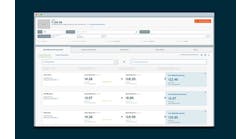The opinions expressed here are my own as a longstanding independent consultant to the equipment rental industry, and do not represent the views of clients, of RER, or any other industry participants.
Over my 28 years in the rental industry, I have seen numerous companies falter or thrive based on their rental rate mentality. When I became CEO of Hertz Equipment Rental in 1982, I set a pricing strategy that essentially turned a blind eye to low-ball competitors. It wasn't easy, given some of the discounts we were up against, but it was just as essential to Hertz back then as it is to every rental company reading this today.
The pricing pain that is being felt throughout the equipment rental industry right now is largely self-inflicted. Poor rate management caused it, and proper rate management can stop it. I understand the temptation to point fingers at competition for dragging down rates. But when it comes to protecting the lifeblood of your business, the competitive bogeyman is a weak excuse.
Despite what empirical evidence may suggest, some equipment rental businesses have been charging proper rental rates right through the depths of the downturn. I can guarantee that — because in an industry this fragmented, there are always smart operators who understand the importance of maintaining a healthy price/value structure.
Unfortunately, these companies seem to be the exception right now. The data that is available, as reported by the public rental companies, shows rate declines in the second quarter of 2010, even though utilization trended upward. Eight out of eight public companies reported higher time utilization in the second quarter of 2010 versus the first quarter, with some increases as high as 9 percent, yet seven of those companies had year-over-year rate declines for the quarter.
Of those, United Rentals lost the least ground, 2 percent, while some others flirted with double-digit declines. Data is unavailable for privately held rental firms, yet I can tell you from my own observation that poor pricing practices apply to many of them as well.
Time utilization up; rates down — what's wrong with this picture? Everything! The rental industry is at a pivotal point in the cycle, and yet rate competition is still at a crescendo. I feel compelled to address the issue.
I am challenging the entire rental industry to show leadership on rates, and every company to take a critical look at its rate practices, or risk failing itself and the industry.
No excuse for self-inflicted rate pain
In the United States and Canada, rental rates went negative in the third quarter of 2007 and haven't seen a positive quarter since then. That's disheartening, but it's more important to focus on where we are today, with higher time utilization than we've seen for some time.
When you have time utilization in the low to mid 60s, the time for rate excuses is over. The rental industry simply cannot afford its current, detrimental pricing practices when demand supports higher rates. It sends the wrong message to customers, discourages investment and drags down performance.
Consider everything that suffers in a rental business when rates decline, starting with lower dollar utilization and EBITDA. A large public company could lose as much as $18 million in annual EBITDA for every point of rate it gives away. Turn that around, and the upside of recovering rate points is enormous. The numbers are less dramatic for a small company, but the profit dynamic is similar.
The flow-through from rental rates, after fixed and variable costs, funds virtually all aspects of a rental business. When rates drop, the ripple effect means cutbacks in capex spending and fleet levels, older equipment, closed branches, layoffs, and in extreme cases, bankruptcy. No rental company can “buy deals” at a loss for any period of time and avoid that descent.
Potential investors in the rental industry want proof that the rental business model is capable of generating a return on capital. If not, the money will be invested elsewhere. For the good of the industry, companies of all sizes have a vested interest in positioning rental as a viable, disciplined business with attractive earnings. For that, you need cost control and a sound pricing structure.
Most rental operators have done a good job of cutting excess costs in the downturn — and that's a good thing. It is essential for the industry to run efficiently. Over the past two years, the cost control leadership shown by many rental companies, large and small, is difficult to reconcile with the poor discipline shown in managing rates.
Leadership and infrastructure
I would postulate that part of the problem stems from a disconnect between management and front-line employees; a disconnect of both mindset and communication. Ask yourself why any employee would rent a machine for $130 if the company's expected rate is $195. The answer is that in the employee's mind, the risk of losing that rental is the determining factor. As the CEO, you don't want that machine to leave the yard for $130, but the message getting through to the employee is “we need revenue.”
In my book Service Success!, I make the point that simple acceptance of market pricing is tantamount to becoming a pawn of both the market and your competition. Your rate structure must also take into account the real cost of doing business and, to a lesser degree, cash flow during slack seasons. To an employee $130 looks better than nothing; whereas you know that it costs you more than $130 to put that equipment on rent.
Fortunately, there is a wealth of technology available today to help manage rental rates. If utilized properly, with tiered checks and balances, these software programs can bring genuine discipline to rate management. In August, McKinsey & Company made exactly that point in its quarterly business journal: “Over the past two decades, most companies have recognized the bottom-line impact to be gained through effective pricing. Yet awareness by itself is not enough.
“Successful companies deliberately build a strong pricing infrastructure that underpins and sustains pricing excellence. [This] demands an investment in systems to collect accurate, current pricing data, as well as tools to turn that data into information … [to] ensure that people who set prices have the data needed to make informed decisions, whether sitting in their own offices or in front of prospective customers.”
Every rental company owns the responsibility
The traditional thinking is that when you price, you hope the competition follows, while expecting that they won't. But this is not a traditional time, and the entire industry must accept rate responsibility together. No one company has the power to sway rental rates in the North American marketplace. There will always be disparity in rates, as there should be in open market competition. But overall, the industry's rate platform must be elevated — this is absolutely imperative.
Rental operators who think they will just flip a switch to recover rates -when things get better are on shaky strategic ground. It is hard work to re-establish higher pricing, especially when your salespeople are shell-shocked from recession combat.
I could give you plenty of examples of industries that learned price discipline the hard way — or too late. The insurance industry has gotten to a place where there is very little emotional connection to brands. Customer behavioral loyalty is high, but attitudinal loyalty is low, meaning that customers will switch brands if it is easier to do so. While some companies work toward establishing customer service as a competitive advantage, price is consistently cited by customers as a top differentiator. This suggests that the insurance industry has reduced itself to a commodity.
The rental industry has the ability to step away from the edge of commodity, and reinforce its position as a service business. Right now, we're on familiar ground; the fluctuations in demand are primarily coming from traditional types of customers who have some familiarity with higher, pre-recession rates. But equipment rental will also reach first-time customers and new markets as the cycle turns. Introducing these customers to unrealistically low rates is self-destructive.
The rental industry's need for rate discipline will only increase as we come out of the downturn. That is when companies must walk the line between adding fleet capacity to meet demand, and dealing with the impact of capacity on rate recovery.
Right now, the industry has an opportunity to move toward a more profitable rate platform, using the fulcrum of current capacity and increased demand. It takes a leader to see that.
Dan Kaplan is CEO of Daniel Kaplan Associates, Morristown, N.J.





